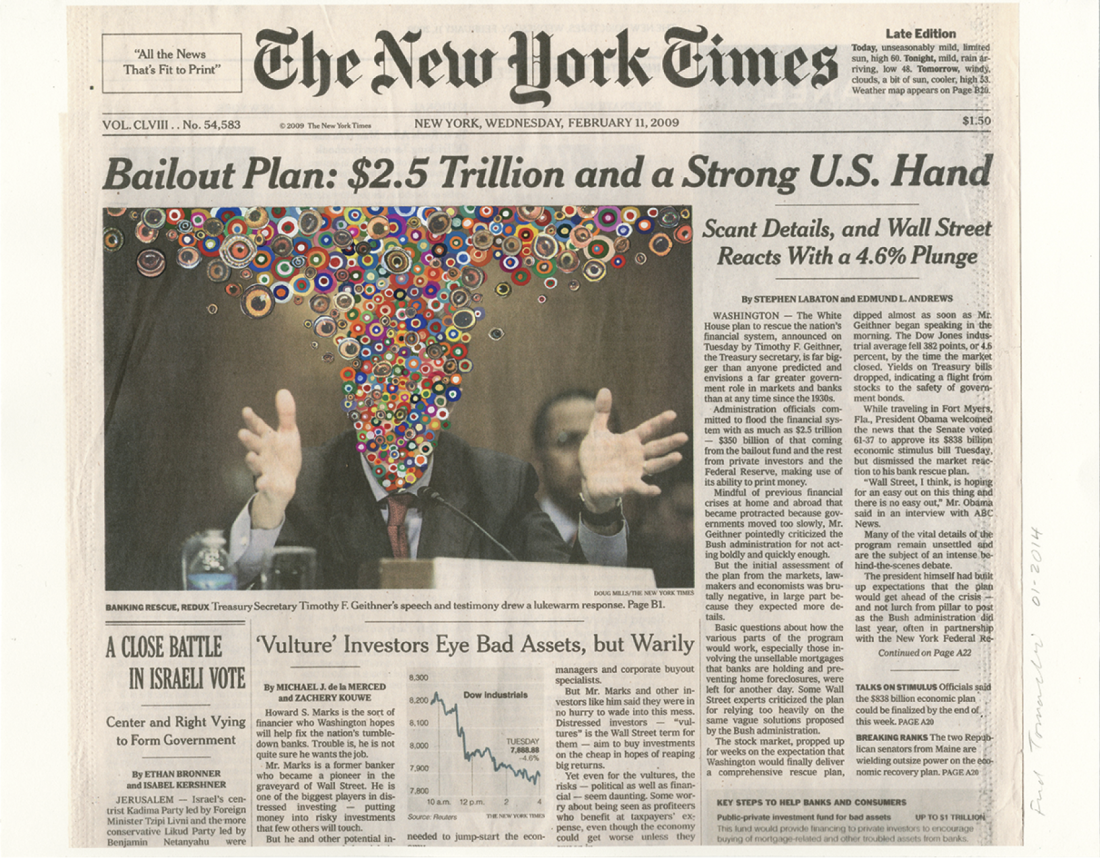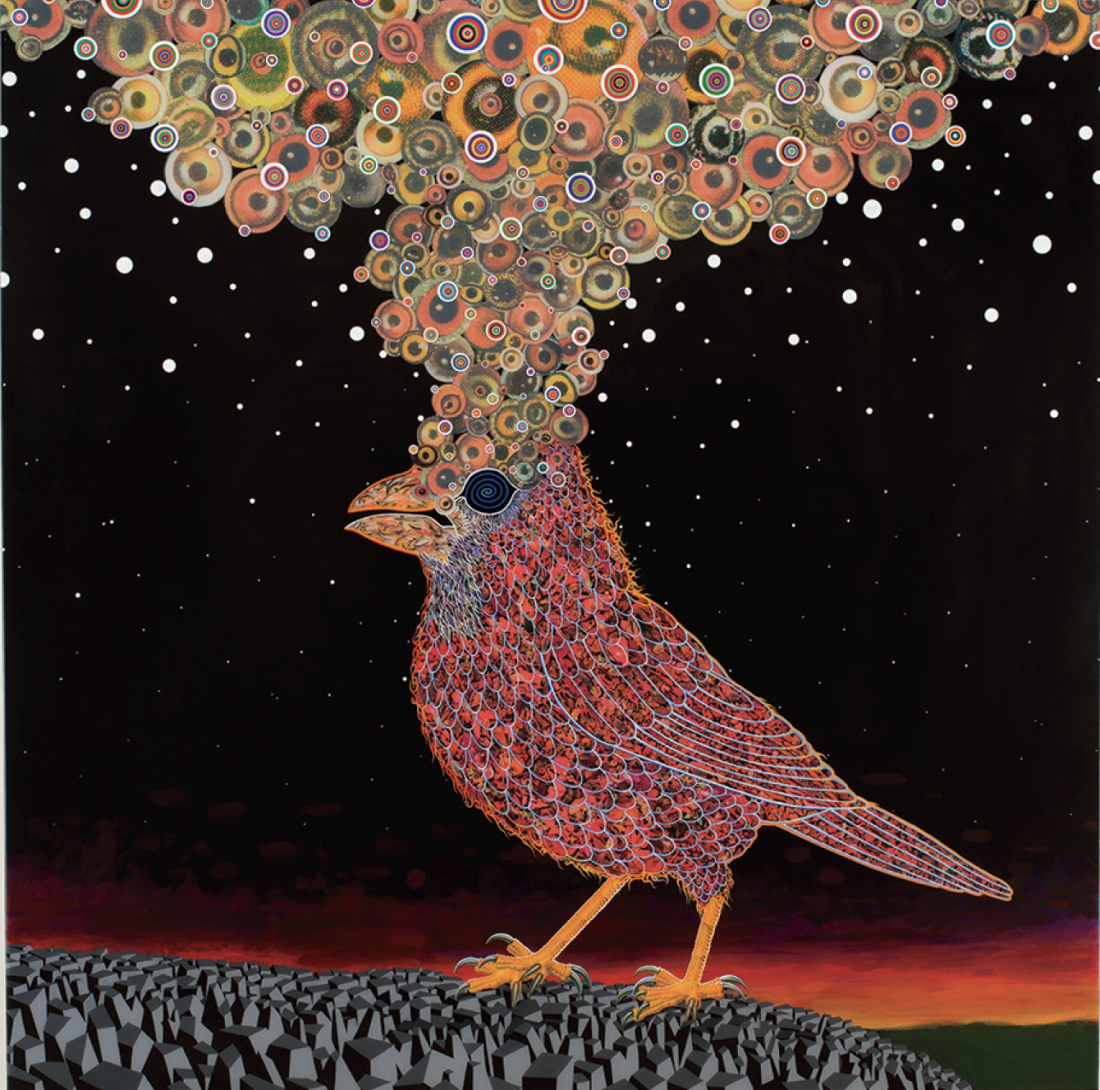Fred Tomaselli
Since 2005, Fred Tomaselli has been working with the covers of The New York Times, scanning part of the front page of the newspaper onto watercolour paper. Initially, he painted in gouache over the main front-page image; later, for intervention, he added collage to his methodology. Each piece is titled by the newspaper’s publication date. Seventy-nine of these Times covers were on show at the Orange County Museum of Art, accompanied by larger works made both before and after the Times project began. Tomaselli’s exhibit was intelligently paired at OCMA with Dieter Roth’s “Piccadillies,” a series of paintings from 1976, where an enlarged reproduction of a postcard of Piccadilly Circus formed the base for the paintings. In both instances, the artist has been concerned with reaction; with investigations of what might be improvised and developed in response to another image by working over it. The New York Times covers and the London postcards both, of course, have their own cultural identities and modes of circulation, and in both cases those are essential to our understanding of the respective artists’ responses.
The technique of Fred Tomaselli’s larger works—those stretching back at least to the Whitney show in 1999—have something of scrapbooking about them; although he paints and the works are referred to as paintings, they frequently feature collection and cutting before arrangement and assembly. Everything is stuck down and preserved in an immaculate coat of resin. The resin provides a kind of visual equivalency between what is painted and what is collaged, an evening out of the different parts of the work and an insistence on its apprehension as a whole.

Fred Tomaselli, Feb. 11, 2009, 2014, collage, gouache and archival inkjet print on watercolour paper, 27.3 x 30.8 cm. Private collection. Courtesy the artist and James Cohan Gallery, New York, Shanghai.
The imagery, and for a time the material itself (smokeable leaf, ingestible capsule), have referred to altered states, or at least to the means to achieve them—to experiences with psychotropic drugs. There has been, and this continues with the Times works, a super-subjective visual overabundance, one built with an attention to making something quite large and complex from very many small things (the simplest and most obvious example being “pills as constellations”). This overabundance extends to the artist’s use of colour, typified by rich, saturated hues with minimal modulation. It may be an overstatement to say that this colour, and the large through small construction of the parts of the pictures, has represented hallucinatory experience, but it has offered a seductive opportunity for imaginative escape. Certain tropes of what has been referred to as “psychedelic” experience are implicated. Our age of lists provides classifications even for those phenomena, and they apply here: increased visual acuity, enhancement of both colour perception and pattern recognition as well as a sense of seeing things under conditions of magnification.
The small-scale works on scanned copies of The New York Times at OCMA continue these practices; a minuscule brush for the gouache, or an X-acto knife to build the collage. The use of these tools invites a viewing distance of just an inch or two. Even so, those “scale wells” (to borrow a phrase from the British artist Keith Tyson) offer us a rabbit hole to fall into; for example, in the painting Nov. 9, 2011, in the centre of Silvio Berlusconi’s mismatched eyes!
In some works Tomaselli’s interventions have clear relationships to the newspaper images: May 15, 2013 (the newspaper image captioned “Jet Star roller coaster coming down”) where the over painting is an iteration of the structure of the roller coaster, or Nov. 8, 2012, where the Times picture is a diagram of exit polling data that Tomaselli has developed into geometric abstraction.
Because we see more of the page and text than that relating to the image, unlikely and provocative juxtapositions occur: on the cover image from Apr. 27, 2011, Tomaselli has over painted blissed-out early season sunbathers, but we find them beside a headline, “Culture of complicity tied to stricken nuclear plant.” Irony and dark humour abound, and the artist’s decision not to edit down what we see on the Times cover pages points to an awareness and intentionality in this regard.

Fred Tomaselli, After Nov. 19, 2013, 2014, photo collage, acrylic and resin on wood panel, 60 x 60 inches. Courtesy the artist and James Cohan Gallery, New York, Shanghai.
At OCMA, there are examples of his use of the Times covers as preparation for larger works: The painting After Nov. 19, 2013, a large work depicting a bird with circles, follows from the cover Nov. 19, 2013, captioned in the newspaper “A Tornado’s path of destruction….” Such relationships are significant pleasures in the show; we see the artist developing an idea in the studio, morning coffee, small brush in hand for a couple of hours with that day’s paper, and the subsequent return to that image in a painting of ambitious scale.
The location of Tomaselli’s intervention in the “grey lady,” the “paper of record” in the USA, requires some scrutiny, as does the status of the newspaper itself, an institution in a parlous state in a rapidly changing media environment. Tomaselli’s studio practice, as he has worked on these covers, necessarily has a quotidian dimension. Every morning there’s another page to scan and work to do. This gives a rhythm to the activity, perhaps something almost like diary keeping. It implies a private act in this art practice, too, one that is detectable in the OCMA show where there is a sense of a 10-year sketchbook having been taken apart and spread over the walls.
And what of that endangered species itself, the newspaper, as a site for painting and collage? The news and weather information is available more readily on our phones; shoulder to shoulder newspaper reading on the subway is long gone, replaced by attention to our little blinking screens. Tomaselli’s method of scanning The New York Times preserves that particular bleached biscuit colour of the paper. Where we see some of the original image beneath his intervention (and we always do) it has a washed out palette that speaks paradoxically of the immediacy of the day’s news and of something older and filtered by a process that is eminently historical—at least to October 1997, when the Times introduced front-page colour. The scanned covers in Tomaselli’s exhibition take us back to an object (the newspaper itself) that has been aestheticized as far back as Braque.
There is a strategy here that ironically assumes authority from the source image and its location; a pleasure, often dark, in repurposing a daily package of image and text into something entirely alternative; what that is shifts in Tomaselli’s painting reactions to the images, but his is a project that questions the stability of what has been termed “the apparatus” (that which comprises all modern technologies and functional elements of society, no less). Given the routines of publication and delivery for newspapers, and the nature of Tomaselli’s interventions here, the Queen’s line in Alice may apply: “Why, sometimes I’ve believed as many as six impossible things before breakfast.” ❚
“Fred Tomaselli: The Times” was exhibited at the Orange County Museum of Art, Newport Beach, from February 15 to May 24, 2015.
Martin Pearce makes paintings and drawings. He teaches in the School of Fine Arts and Music at the University of Guelph.

